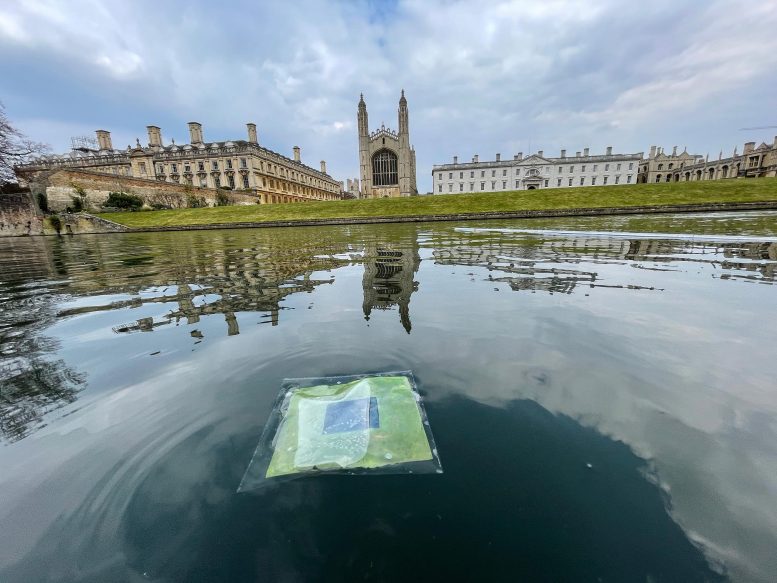
A floating artificial leaf – which generates clean fuel from sunlight and water – on the River Cam near King’s College Chapel in Cambridge, UK. Credit: Virgil Andrei
Scientists have developed floating ‘artificial leaves’ that generate clean fuels from sunlight and water. They could eventually operate on a large scale at sea.
The ultra-thin, flexible devices, which take their inspiration from photosynthesis – the process by which plants convert sunlight into food – were designed by researchers from the University of Cambridge. Since the low-cost, autonomous devices are light enough to float, they could be used to generate a sustainable alternative to gasoline without taking up space on land.
Outdoor tests of the lightweight leaves on the River Cam showed that they can convert sunlight into fuels as efficiently as plant leaves. River Cam is the main river flowing through Cambridge in eastern England, and the testing occurred near iconic Cambridge sites including the Bridge of Sighs, the Wren Library, and King’s College Chapel.
Researchers from the University of Cambridge designed ultra-thin, flexible devices, which take their inspiration from photosynthesis – the process by which plants convert sunlight into food. Since the low-cost, autonomous devices are light enough to float, they could be used to generate a sustainable alternative to gasoline without taking up space on land. Credit: Virgil Andrei
This is the first time that clean fuel has been generated on water. If it were scaled up, the artificial leaves could be used on polluted waterways, in ports, or even at sea, and could help reduce the global shipping industry’s reliance on fossil fuels. The results are reported today (August 17, 2022) in the journal Nature.
Renewable energy technologies, such as wind and solar, have become significantly cheaper and more available in recent years. However, for industries such as shipping, decarbonization is a much taller order. Around 80% of global trade is transported by cargo vessels powered by fossil fuels, yet the sector has received remarkably little attention in discussions related to the climate crisis.
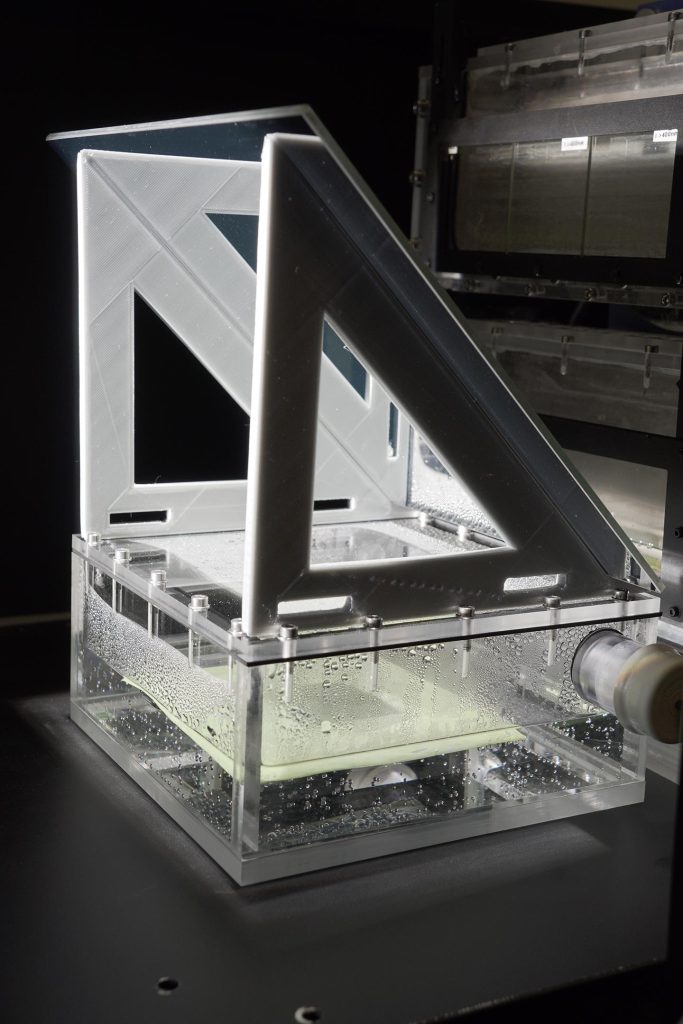
Researchers from the University of Cambridge have designed ultra-thin, flexible devices, which take their inspiration from photosynthesis – the process by which plants convert sunlight into food. Since the low-cost, autonomous devices are light enough to float, they could be used to generate a sustainable alternative to gasoline without taking up space on land. Credit: Virgil Andrei
For several years, Professor Erwin Reisner’s research group in Cambridge has been working to address this problem by developing sustainable solutions to gasoline that are based on the principles of photosynthesis. In 2019, they developed an artificial leaf, which makes syngas from sunlight, carbon dioxide, and water. Syngas is a key intermediate in the production of many chemicals and pharmaceuticals.
The earlier prototype produced fuel by combining two light absorbers with suitable catalysts. However, it incorporated thick glass substrates and moisture-protective coatings, which made the device bulky.
“Artificial leaves could substantially lower the cost of sustainable fuel production, but since they’re both heavy and fragile, they’re difficult to produce at scale and transport,” said Dr. Virgil Andrei from Cambridge’s Yusuf Hamied Department of Chemistry, the paper’s co-lead author.
“We wanted to see how far we can trim down the materials these devices use, while not affecting their performance,” said Reisner, who led the research. “If we can trim the materials down far enough that they’re light enough to float, then it opens up whole new ways that these artificial leaves could be used.”
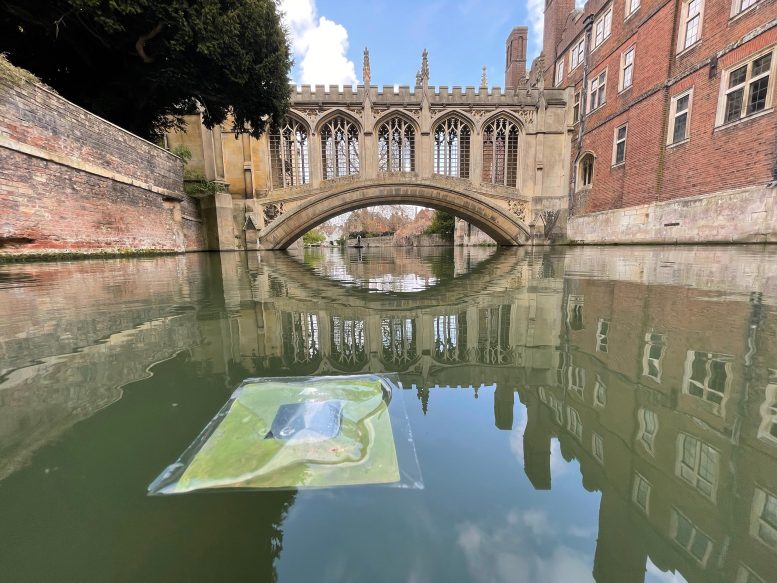
A floating artificial leaf – which generates clean fuel from sunlight and water – on the River Cam near the Bridge of Sighs in Cambridge, UK. Credit: Virgil Andrei
For the new version of the artificial leaf, the scientists took their inspiration from the electronics industry. Miniaturization techniques there have led to the creation of smartphones and flexible displays, revolutionizing the field.
The challenge for the Cambridge research team was how to deposit light absorbers onto lightweight substrates and protect them against water infiltration. To overcome these challenges, the researchers used thin-film metal oxides, and materials known as perovskites, which can be coated onto flexible plastic and metal foils. The devices were covered with micrometer-thin, water-repellent carbon-based layers that prevented moisture degradation. The result was a device that not only works, but also looks like a real leaf.
“This study demonstrates that artificial leaves are compatible with modern fabrication techniques, representing an early step towards the automation and up-scaling of solar fuel production,” said Andrei. “These leaves combine the advantages of most solar fuel technologies, as they achieve the low weight of powder suspensions and the high performance of wired systems.”
Tests of the new artificial leaves demonstrated that they can split water into hydrogen and oxygen, or reduce CO2 to syngas. While additional improvements will need to be made before they are ready for commercial applications, the scientists say this development opens whole new avenues in their work.
“Solar farms have become popular for electricity production; we envision similar farms for fuel synthesis,” said Andrei. “These could supply coastal settlements, remote islands, cover industrial ponds, or avoid water evaporation from irrigation canals.”
“Many renewable energy technologies, including solar fuel technologies, can take up large amounts of space on land, so moving production to open water would mean that clean energy and land use aren’t competing with one another,” said Reisner. “In theory, you could roll up these devices and put them almost anywhere, in almost any country, which would also help with energy security.”
Reference: “Floating perovskite-BiVO4 devices for scalable solar fuel production” by Virgil Andrei, Geani M. Ucoski, Chanon Pornrungroj, Chawit Uswachoke, Qian Wang, Demetra S. Achilleos, Hatice Kasap, Katarzyna P. Sokol, Robert A. Jagt, Haijiao Lu, Takashi Lawson, Andreas Wagner, Sebastian D. Pike, Dominic S. Wright, Robert L. Z. Hoye, Judith L. MacManus-Driscoll, Hannah J. Joyce, Richard H. Friend and Erwin Reisner, 17 August 2022, Nature.
DOI: 10.1038/s41586-022-04978-6
The research was supported in part by the European Research Council, the Cambridge Trust, the Winton Programme for the Physics of Sustainability, the Royal Academy of Engineering, and the Engineering and Physical Sciences Research Council (EPSRC), part of UK Research and Innovation (UKRI). Virgil Andrei and Erwin Reisner are Fellows of St John’s College, Cambridge.

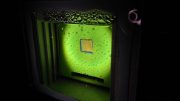
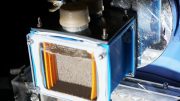
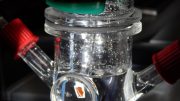
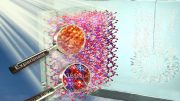
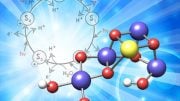



Any chance they could be made of something that does not include floating tons of plastic in the waterways?
While this is interesting research, how do you preserve a ‘fragile’ technology on the water? Fish & mammals breach the surface and would damage the ‘fragile’ floating leaves. How will you prevent birds from damaging the items let alone storms that will toss these items around?
Organic energy tech is here. PLant a tree and watch light up the city like an x-mas tree. Literally speaking.